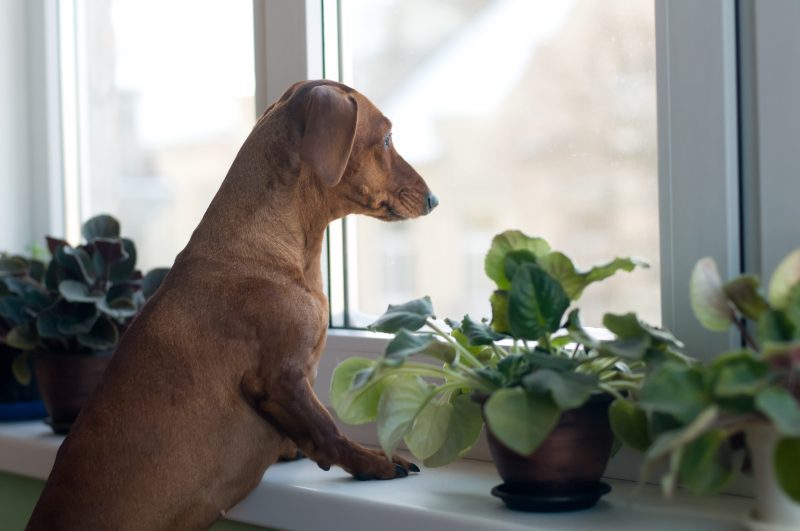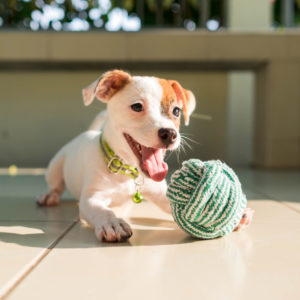What is separation anxiety?
Separation anxiety is a behavioural disorder that causes dogs to be destructive and in severe distress when left alone. It is estimated that 1 in 6 dogs are affected. Some dogs will start showing symptoms when their owners start preparing to leave the home, only to intensify once they are alone. Separation anxiety is one of the most common causes of dogs being rehomed or surrendered to animal shelters due to its high financial and emotional cost.
It is important to note separation anxiety is not the same as misbehaving or being untrained. A dog may urinate in the house or rip up a pillow while you are away, but perhaps they weren’t able to hold their bladder that long or were simply bored. Separation anxiety is generally more severe and occurs every single time the dog is alone.
What are some common symptoms?
- Persistent barking, whining or howling when left alone.
- Pacing in circles or in straight lines back and forth.
- Urinating or defecating every time they are left alone.
- Chewing on or destroying household objects (pillows, furniture, plants, etc.)
- Digging at doorways and windows
- Trying to escape through doors or windows, sometimes to the point of self injury
- Excessive drooling
- Dilated pupils
- Acting as if it has been years since they last saw their owners upon return.
The easiest way to discover if one or many unfavourable or destructive behaviours are associated with separation anxiety are to ask the following questions:
- Does it happen every time you leave the house?
- Does it happen when you are home or only in your absence?
- Does your dog start showing signs of anxiety as you are preparing to leave?
Generally, signs of separation anxiety only occur when you aren’t home or as you are preparing to leave. Anything that happens while are sitting on the couch at home is most likely from another cause.
Why does my dog have separation anxiety?
There is no one specific cause of separation anxiety. However, some potential triggers include:
- Change of owner/family
- Death or loss of owner or family member the dog was bonded to
- Moving to a new home
- An abrupt change in schedule (suddenly spending more time alone than they are used to)
- A traumatic experience in the past
- Some dogs are genetically predisposed
- Most studies show 60-70% of affected dogs are male (both intact and neutered).
- Approximately 50% of affected dogs are mixed breed.
- Other breeds we commonly see with separation anxiety include German Shepherds, Australian Shepherds, Labrador Retrievers, Vizslas, Border Collies, Cocker Spaniels, Bichon Frises, Cavalier King Charles Spaniels, Italian Greyhounds, Toy Poodles, Havanese, and German Shorthaired Pointers.
How is separation anxiety treated?
Extremely severe cases of separation anxiety can be treated by a veterinarian with prescribed anxiety medications. However, milder cases may not require medical intervention.
Counterconditioning
Counterconditioning is a way to desensitize your dog to a situation that may cause reactions of aggression, fear or anxiety. It is done by associating the situation (or object, person, other animals, location, etc) with something positive and pleasant that the dog enjoys. This usually only works with very mild cases of anxiety.
Whatever you are choosing to associate with your dog being alone should ONLY be given in that specific situation and shouldn’t be available to them while you are home. An example of this method is giving a Kong toy (or something similar) stuffed with food or a yummy treat, such as peanut butter or cottage cheese, every time you leave the house. This should give your dog at least 20-30 minutes of distraction to finish getting all of the food out of the toy.
Desensitization
With more severe anxiety, your dog will require a more complex treatment method. Desensitization involves gradually getting your dog used to being alone, starting with short separations and continually increasing the length of time they are alone. This usually takes approximately 8 weeks of daily sessions, so it is no easy task! The following steps are a great way to go about desensitization.
- Some dogs’ anxiety starts when they notice you getting ready to leave, so start with the pre-departure cues. This means putting on your coat or picking up your keys several times a day in varying order without actually leaving the house. This will help your dog not associate these cues with you always leaving them alone. This can take weeks so make it part of your routine and don’t give up on it!
- The next step is to leave your dog alone for short periods of time. Start very simple, with making your dog sit and stay and then leaving the room for a few minutes, gradually increasing the time you are out of your dog’s sight. You can incorporate the pre-departure cues into this step as well.
- After your dog is fairly comfortable with out-of-sight stays inside the home, you can try moving to an exit door and doing the same thing. Go outside of the house for just one or two seconds, slowly building it up.
- When you can be out of the house for 10 seconds or more without your dog showing anxiety, try throwing counterconditioning into the mix and give your dog a treat or toy as you leave.
- Continue to increase the time you are out of the house. Watch for signs of stress and anxiety. If your dog starts showing these signs, take a step back and shorten the length of time you are gone to where your dog is comfortable and relaxed again, and increase the time more slowly.
- A 40-minute absence without your dog showing separation anxiety is the big hurdle you want to get over. This can take a lot of time and a lot of work on your part. The reason for this is because most dogs have anxiety responses within the first 40 minutes of being alone.
- Once the dog is comfortable with 40 minutes, start increasing the time by larger increments beginning with 5 minutes, then later 15 minutes, etc.
- When the dog achieves a full 90 minutes, you should be safe to leave for 4-8 hours. To be safe, you can try 4 hours first and see how the dog does.
Throughout the entire exercise, it is important you keep all hellos and goodbyes very calm and not a big spectacle. You want to show your dog that coming in and going out of the home are calm and casual everyday occurrences and there is no need for a dramatic display of emotion.
Crate Training
Using a crate can be helpful for some dogs and harmful for others. Sometimes, they learn that the crate is their safe place when left alone. Other dogs may have even more stress and anxiety being put in a crate. Consider this and closely monitor your dog’s reaction to being crated if you want to go this route.
Written by Stephanie, RVT




